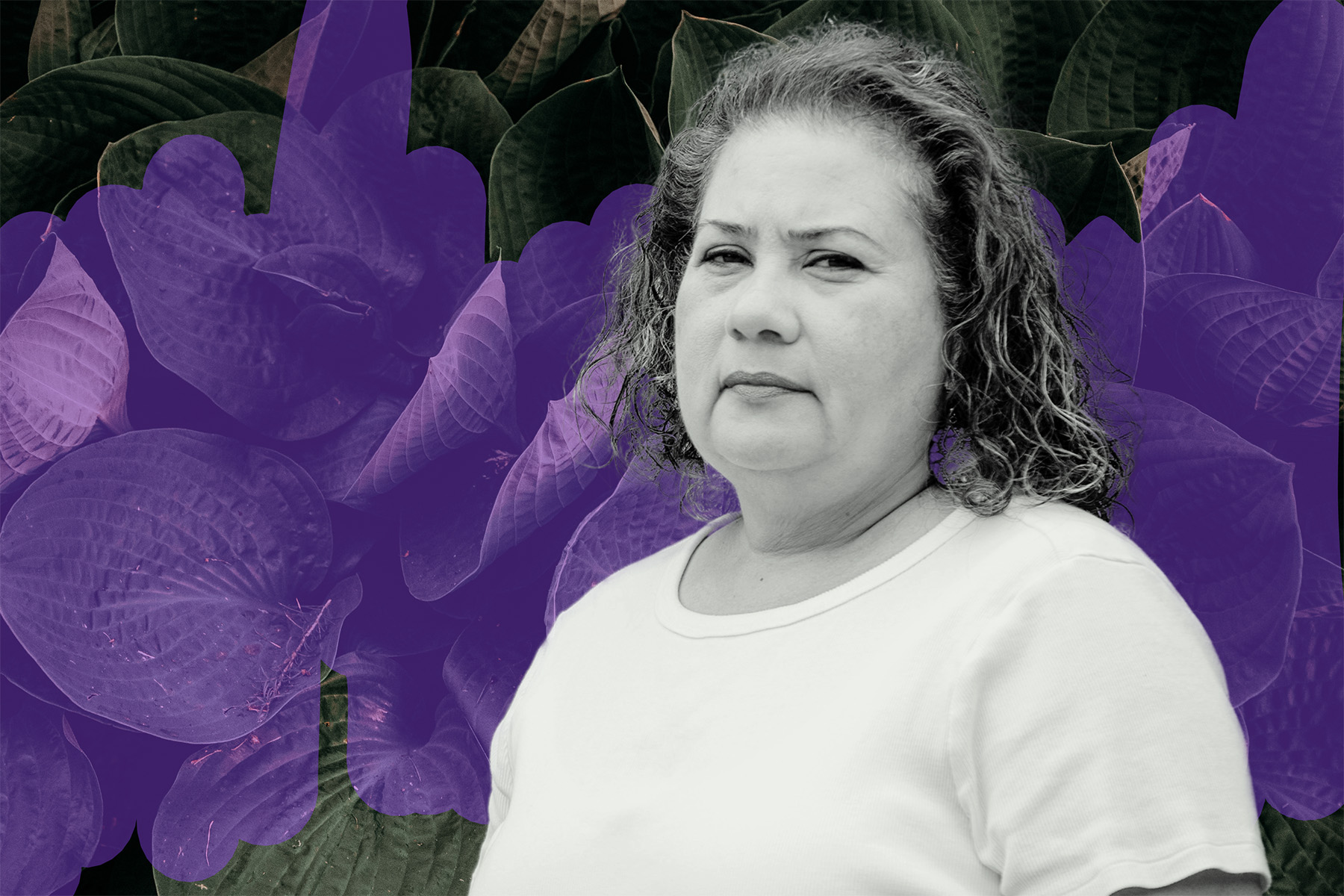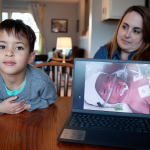This story was co-published with Triad City Beat as part of the Equitable Cities Reporting Fellowship For Racial Justice Narratives, a joint project between Triad City Beat and Next City.
Love was in the middle of moving back to her hometown of Greensboro, North Carolina, from Raleigh when she found out she was pregnant with her first child. It was 2020, and she and her husband had always wanted to start a family.
“I was happy,” she says. “We’ve been trying to get pregnant for a while.”
But when the mom-to-be began to navigate the local health care system, her happiness turned into frustration. In her first trimester, Love bounced from one OB-GYN to another, never truly landing on one who asked her about her wants and needs or discussed any risks. She was constantly being referred to other providers and doctors.
“I was told to go to one provider, and then another,” says Love, who agreed to share her story on the condition of anonymity. “And I always felt like I was having to explain myself over and over, so that provider could get to know me.”
The problem was with Love’s insurance. For some pregnant people, insurance does not cover enough expenses, or they don’t have coverage at all — which can have real medical consequences. But for the past two decades, a program in North Carolina’s Guilford County has been working to fill that gap and provide people like Love with high-quality care.
Widening the safety net
At the time of her first pregnancy, Love had a high-deductible plan through her job as a mental health professional. Though it covered her primary care well enough, it gave her few options when she became pregnant. From a lack of choice in providers to pricey co-pays for pregnancy-related services, her care was minimal, inconsistent and expensive.
“I had a plan where I had to pay like $6,000 before they would pay for anything,” Love says. The price for maternal care cost Love around $400 per month. In her second trimester, she routinely visited an OB-GYN working for the Guilford County Health Department. When she went to the receptionist, she was informed that her appointments were going to continue to come with a hefty price tag.
But there was help. They told her that Guilford County residents could receive financial aid from a program called Adopt-A-Mom, run by Every Baby Guilford County. The program could help cover her expenses for maternal care if she was ineligible for Medicaid. She was.
For Love, Adopt-A-Mom did more than help with expenses. It finally gave her the pregnancy and birthing experience she wanted.
Love is what the Guilford County Department of Health considers “underinsured.” According to the most recent Commonwealth Fund Biennial Health Insurance Survey done in 2022, people who are underinsured have access to health insurance all year “but their coverage doesn’t enable affordable access to health care.”
The same survey found that 43 percent of working age adults were inadequately insured: 9 percent were uninsured, 11 percent had gaps in coverage and the remaining 23 percent were underinsured. This is despite record highs in national coverage.
Being underinsured or not insured at all causes financial hardship for pregnant people. According to the Guttmacher Institute, the high costs of pregnancy hinders people from getting early care and therefore increases the chance of pregnancy complications — including infant mortality.
That’s something experts in Guilford County have known for decades. In 1988, a group of local medical practitioners studied the reasons behind the high rates of infant mortality and found that many pregnant people were either underinsured or didn’t qualify for Medicaid. And as is the case nationwide, Black people suffered the highest level of infant mortality.
To help eliminate disparities in prenatal care and parenthood, county officials created the nonprofit Guilford County Coalition on Infant Mortality in 1991. Three years later, they launched Adopt-A-Mom, a program which helps coordinate prenatal care for expectant parents who are ineligible for Medicaid and who are experiencing a low- to medium-risk pregnancy.
Jean Workman, the program director of Every Baby Guilford, defines a low- to medium-risk pregnancy as a pregnancy in which the birthing person has normal blood pressure and isn’t dealing with gestational diabetes.
“This means if they were able to get into early care, they’re not having to mitigate any issues,” Workman says. In other words, if the barrier to a safe pregnancy can be helped with regular appointments and financial support, Adopt-A-Mom can help. (Higher-risk pregnancies are usually defined by other health conditions and age.)
Adopt-A-Mom works by developing relationships with various OB-GYNs across the county, asking them to provide services to their clients at reduced prices. This year Adopt-A-Mom has contracted with seven providers.
Their clients get to choose from the list of providers, and the program covers the cost of the visit. They also negotiate discounted rates for lab work and ultrasounds on their clients’ behalf.
Although the first major racial disparity the county found was between Black and White people, Workman is also worried about another growing population of Adopt-A-Mom clients: uninsured Latinx people. Since 2020, Workman and her team found that there was an increasing need that she guesses might be from a general increase in the Latinx population as a whole.
Since the 2020 census, Guilford County has seen about a 10 percent increase in the Latinx population. As of 2019, there were about 15,000 people with an “unauthorized” status, the majority of which are from Mexico. About 42 percent were women and mostly of reproductive age. For Adopt-A-Mom, that figure is relevant because it means more people who are ineligible for Medicaid. The lack of a safety net like Medicaid creates a culture of reaction versus prevention. Elbia Altamirez, patient coordinator for Adopt-A-Mom, explains that when people lack insurance or are underinsured they’re less likely to attend regularly scheduled check-ups, or take over-the-counter medications for chronic symptoms, and only interact with the local health care system in costly emergency room visits. And that same thinking doesn’t change with pregnancy.
“A lot of individuals that we serve, since they don’t have or they don’t qualify for Medicaid, they don’t have medical coverage and they don’t have the means to pay for that,” Altamirez says. “So 90 percent of the time they are not even enrolled in medical practices.”
Many states have some version of Medicaid or CHIP —the government-subsidized health insurance program for kids — or Medicaid expansion. Some are for “lawfully residing” immigrants, or there are some expansions just for pregnant undocumented immigrants, or only for undocumented children. Some states like Florida and Arizona have a limited waiver.
Just this year, California became the first state in the nation to expand health care to undocumented immigrants through their low-income state insurance program Medi-Cal. North Carolina also recently expanded its Medicaid coverage in December 2023, but only by income limits, which Wakeman says helped a lot more Black families find coverage.
“Unfortunately Medicaid expansions [in NC] have never covered undocumented immigrants,” Wakemen says. “But that’s why our programming needs more support than ever.”
Since its founding, Adopt-A-Mom has helped nearly 10,000 people. “And it’s only growing,” says Altamirez.
Improving outcomes for the most vulnerable
Love chose to have a home birth for both of her pregnancies — the most recent baby, another boy, came last October. For her, the choice came easily. Advocating for one’s own medical and mental health is something she helps her own clients do as a mental health professional.
“They were pretty open to it,” Love says about the program’s support. “I let them know pretty early on like, ‘Hey, I’m not a radical. If there’s something that you feel like I need, I’m always open and receptive to that.’ Whatever [clinicians] recommend, I’ll go back, do some research and when I come back, I have an answer as to if I would like to move forward with this or not, and I’ll tell you why.’ But I do like to make those informed decisions.”
She’s well aware that the experience for other pregnant people may not be as smooth.
“I’ve heard other stories with women who go to a provider and the provider is kind of against whatever it is that they want and so they don’t feel comfortable saying things like, ‘I’m having a home birth,’” she says. “Some people keep that a secret, when in reality is, you know, everyone’s on the same page or outcomes can be better.”
It’s a story that is common for a lot of people, but particularly for Black people. According to the Centers for Disease and Control and Prevention, Black women are three times more likely to die of pregnancy complications compared to White women even though 80 percent of pregnancy-related deaths are preventable.
Those statistics echo in Guilford County. Despite Adopt-A-Mom’s efforts, and the overall infant mortality rate trending down, Black babies still make up the majority of infant deaths in the county. Adopt-A-Mom’s 2022 Report shows that Black babies make up 52 percent of all infant deaths.
According to the Commonwealth Fund, things like lack of empathy, the failure to hire and retain Black doctors, lack of communication, poor outpatient follow-ups, a long racist history with unethical medical experiments on Black bodies (some of the most egregious are in the field of obstetrics and gynecology), and other elements contribute to the high rate of medical mistrust within Black communities. So Love isn’t surprised that Black maternal mortality is in the headlines these days.
“I can only imagine someone that doesn’t have my level of experience and knows how to navigate certain systems and do research,” she says. “They would probably feel very hurt [by the health care system].”
But there is a growing movement nationwide to change that. Democratic U.S. Reps. Alma Adams, from North Carolina, and Illinois’ Lauren Underwood, for instance, established the Black Maternal Health Caucus which aims to make improvements in Black maternal care and pregnancy outcomes a national priority.
“The statistics around Black maternal health are horrifying, and they haven’t improved in 30 years as maternal health outcomes overall have worsened,” Underwood said in a press release announcing the caucus’s founding. “But this issue extends beyond statistics for too many women and families, it’s their reality.”
Then there is the Black Mamas Matter Alliance, or BMAA. The group serves as a resource and podium that amplifies the work of their 40 partners which are locally-based organizations that provide various services. Atlanta Doula Collective for example, provides professional labor support and sometimes even at a discounted rate when funding is available.
Another BMAA partner is Black Health New Mexico. The organization is part practice, part health educator and part advocacy group. They’ve created a mental health program for new parents, contributed to a curriculum for young parents and have helped galvanize practitioners and organizations for equity in Black and BIPOC health. What all of BMAA’s partners have in common is they all work to advance Black maternal health, rights and justice.
As for Love, she’s grateful she had a local program like Adopt-A-Mom for both of her pregnancies. It allowed her to meet with her doula who introduced her to a lactation specialist. Her doula even began attending birth classes with her and her husband. Both of her pregnancies were healthy, and both went according to her plan.
“When it comes to birth, so many people are unprepared,” she says. “It’s not enough for it to be just you. You really need some people in your village to be a part of it.”






